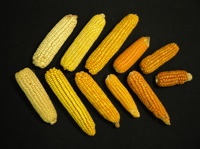![]() A paper 1 and commentary 2 in the latest Science make pretty compelling reading for anyone with an interest in how climate change will affect agriculture and food security. Long-standing readers will remember a little round-up that included the work of our chums Andy Jarvis and Annie Lane. They predicted the effect of climate change on the suitability of different areas for different crops. David Lobell and his colleagues at Stanford University take a different tack, to answer a slightly different question: what are the top priorities for investing in agriculture to cope with climate change.
A paper 1 and commentary 2 in the latest Science make pretty compelling reading for anyone with an interest in how climate change will affect agriculture and food security. Long-standing readers will remember a little round-up that included the work of our chums Andy Jarvis and Annie Lane. They predicted the effect of climate change on the suitability of different areas for different crops. David Lobell and his colleagues at Stanford University take a different tack, to answer a slightly different question: what are the top priorities for investing in agriculture to cope with climate change.
They isolated 12 regions where most of the world’s malnourished people are concentrated. Then they analyzed 20 different climate change models to get a feel for how temperature and rainfall would change in those areas. And finally, they looked at the specific crops that people in those regions eat and used past correlations between yield and temperature and yield and rainfall to predict how those crops might respond to the predicted changes in climate. This is an important step. As the researchers point out, “Rice, maize and wheat contribute roughly half of the calories currently consumed by the world’s poor and only 31% of the calories consumed by those in sub-Saharan Africa”. There’s a whole bunch more jiggery-pokery in there that ends up allowing the researchers to come up with best and worst case scenarios for each of the regions they consider, and some sharp conclusions.
Southern Africa and South Asia are going to be hit hard. Maize in Southern Africa and wheat and millet in South Asia are likely to show large declines. But there are also regions with large uncertainty, with some models predicting an increase and others a decrease. Groundnut in South Asia and sorghum in Southern Africa are examples of these, probably because the historical data on yield correlations are poor.
The results are summed up in a table that, the authors point out, could help agencies decide where to invest scarce resources. Those that are really risk averse might focus on wheat in South Asia, rice in Southeast Asia and maize in Southern Africa, all of which are predicted to drop by all the models. An investment in those crops is most likely to generate “some benefits”. A different view would be that investment should focus on crops and regions where at least some of the models predict strong depression of yields, because even if the projection is unlikely, if it does happen the consequences will be great. Many crops in South Asia, along with sorghum in the Sahel and maize in Southern Africa fall into this group.
The bigger question is, what form should those investments take? This is where the commentary adds its 2 cents worth. Molly Brown and Christopher Funk point out a double-whammy awaiting poor farmers:
In food-insecure regions, many farmers both consume their product and sell it in local markets. This exposes farmers to climate variations, because when they produce less their income goes down while their costs go up to maintain basic consumption. Large-scale hunger can ensue, even when there is sufficient food in the market that has been imported from elsewhere.
The solution that Brown and Funk see is largely technological; irrigation, fertilizers, improved varieties. Indeed, they aver that “technological sophistication determines a farm’s productivity far more than its climatic and agricultural endowments,” and of course at one level they are right. They also say that “poor farmers in the tropics will be less able to cope with changes in climate because they have far fewer options in their agricultural systems to begin with”.
I wonder whether that is correct. For the most marginal farmers, without irrigation or fertilizers or improved varieties, options — in the form of agricultural biodiversity — is all they do have. Development agencies are again starting to pay attention to agricultural research, and the Lobell paper and others on climate change are going to help them focus their efforts. It is clear that all approaches will need to be explored, among them helping people to adopt new foods in their diets and cultures. Will that include helping the most marginal farmers to use agrobiodiversity — local and exotic — to secure their food supplies in the face of climate change?
